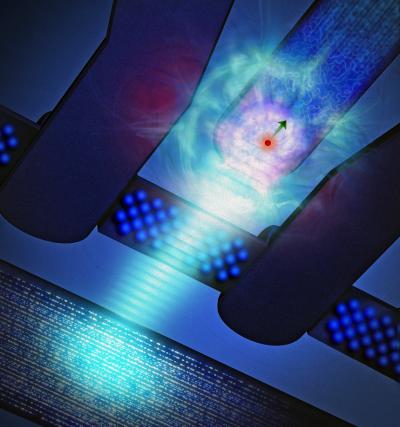A team of scientists from the University College, London, and University of Melbourne, headed by Professor Andrew Dzurak and Dr Andrea Morello from the School of Electrical Engineering and Telecommunications at University of New South Wales (UNSW), has developed the first functional quantum bit (qubit) based on a single silicon atom.
 This is an artist’s impression of a phosphorus atom (red sphere surrounded by electron cloud, with arrow showing the spin direction) coupled to a silicon single-electron transistor. A burst of microwaves (blue) is used to ‘write’ information on the electron spin. (credit: Tony Melov)
This is an artist’s impression of a phosphorus atom (red sphere surrounded by electron cloud, with arrow showing the spin direction) coupled to a silicon single-electron transistor. A burst of microwaves (blue) is used to ‘write’ information on the electron spin. (credit: Tony Melov)
Qubit is the fundamental data unit of future quantum computers. The research team read and wrote data utilizing the magnetic orientation or spin of an electron bound to a phosphorus atom integrated in a silicon chip. This is a significant step towards the realization of a silicon quantum computer built upon single atoms, said Dzurak.
The study results have appeared in the Nature journal. In 2010, the same UNSW team elucidated its ability to read the spin state of an electron in the same journal. In this new study, the team demonstrated the ability to write the state of the electron spin, thus concluding the two-stage process needed to develop a working qubit. Utilizing a microwave field, the researchers were able to manipulate an electron bound to a phosphorous atom embedded alongside a uniquely designed silicon transistor. Professor David Jamieson from the School of Physics at the University of Melbourne headed the group that accurately embedded the single phosphorous atom in the silicon device.
Lead author, Jarryd Pla stated that the researchers were able to separate, measure and manipulate an electron of the single atom with the help of a device that was fabricated in the same way as a typical silicon computer chip. This is the quantum counterpart of typing a numeral using a keyboard and was performed for the first time in silicon, informed Dr Morello.
The team's next step is to couple qubit pairs to form two-qubit logic gates, the fundamental processing units of future quantum computers.